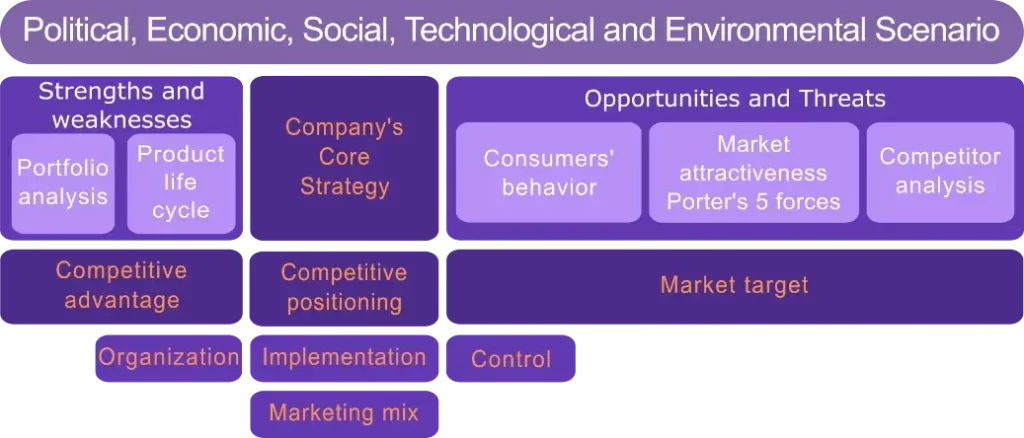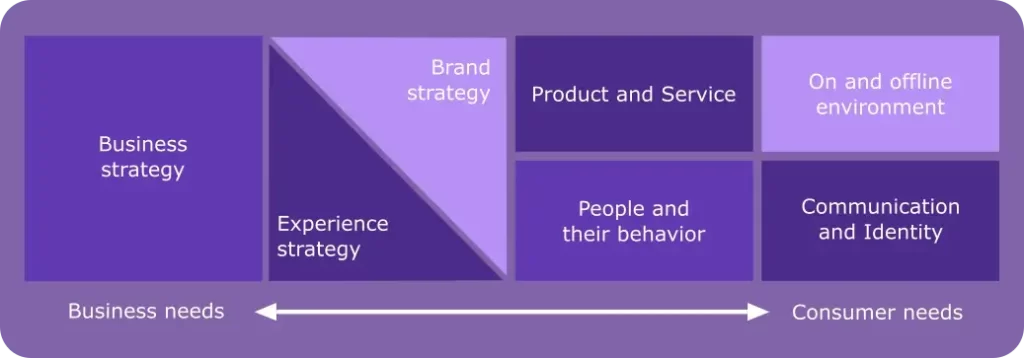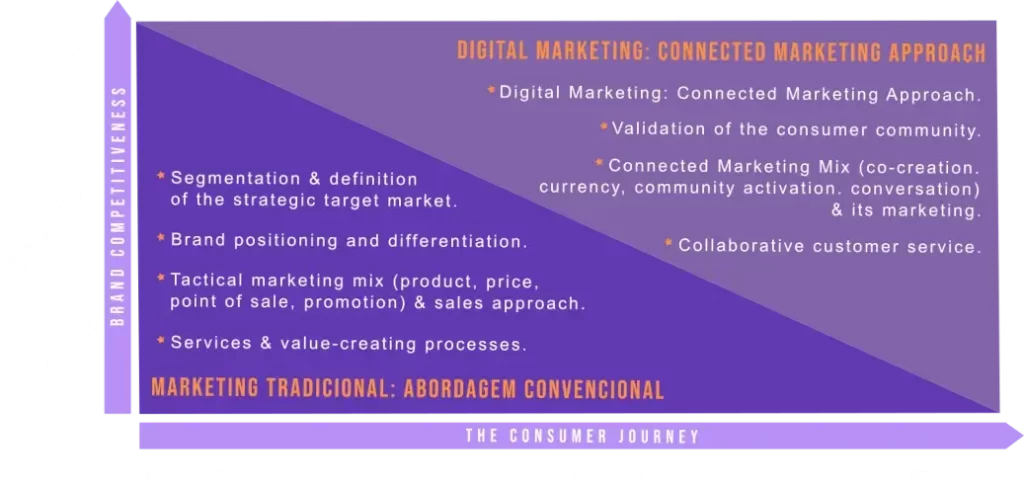Strategic marketing planning, the path to achieving your market goals.
How to create and sustain superior market performance, maximizing the experience for consumers and profits for investors.
“Ajudaremos você a construir um planejamento estratégico de marketing que levará a uma valorização ainda maior da sua marca, validará a Estratégia central da empresa, o posicionamento competitivo e os Objetivos de vendas. Além disto, definirá as principais iniciativas das diferentes áreas de marketing: inteligência de mercado, comunicação off-line e on-line, gerência de produtos e trade marketing, e os respectivos budgets.”
Ferramentas para desenvolver o plano de marketing

1. The company's core strategy and competitive positioning.

To decide what the core strategy and competitive positioning will be, we will define the critical success factors (CSFs). These are the result of an analysis of the market’s opportunities and threats compared to the company’s strengths and weaknesses.
At the end of this first exercise we will be faced with two possibilities of how to compete: by value of products and services or by price, but to make this decision well it is essential to understand the structure of the markets.
Choosing a low price tends to reduce the value of the market as a whole, but there are products that don’t have a choice, such as commodities. In these cases, efforts should be concentrated on reducing production costs.
When the central strategy is to achieve competitive advantages, it becomes essential to define the positioning via the 4Ps – Product, Price, Place and Promotion of traditional marketing and the 4C’s of Digital Marketing – Customer, Cost, Convenience and Communication, which put the customer in focus.
2. Brand
We will define or revisit your brand strategy and its mission, vision and values, in line with the company’s core strategy and competitive positioning.
We will use Interbrand’s platform as a reference to develop the path that links business strategy to the consumer experience.

3. Market segmentation: one of the keys to success.
“We will work intensively with you at this stage. First we’ll identify the existing segmentations and then we’ll define the ones we want to be in, possibly with different company brands.”
We will recognize sub-segments that are growing and that we don’t yet have the right products for, indicating the need for innovation. In this scenario, it will be necessary to carry out a case study to confirm whether the hypotheses we have constructed have a viable payback.
4. Positioning
For existing products, we will revisit the traditional 4 Ps of marketing (Product, Price, Place and Promotion) to see if there are any opportunities for repositioning and then define or validate the 4Cs of digital marketing (Customer, Cost, Convenience and Communication), which put the customer in the spotlight.

We will define the marketing initiatives.

Who are the clients or consumers of this product?
Defining the “persona”, understanding the buying journey.
“Nowadays it’s no longer possible to guarantee that all consumers will follow the same path, which is another challenge for digital marketers.”

Which product will be sold? What are the specifications? What is its competitive edge? What problems does it solve?
At what stage of the life cycle is each product?
Is it necessary to bring innovation to the market? Which ones? Briefing for the development department and carrying out a case study.
What are the pricing strategies? Price per channel?
Promotions?


What are the strategies for defining sales channels?
B2C, B2B, B2B2C?
What are the trade marketing strategies?
What are the e-commerce strategies?
Quais são as informações secundárias de mercado que devemos monitorar?
What is the primary information, i.e. which market performance surveys should we buy and analyze?
- Kantar, Nielsen or both, as they provide complementary data?
*Kantar: a consumer panel that provides information on household penetration, purchase volumes and prices paid.
**Nielsen: a panel that collects information from points of sale and provides information on the importance of sales channels and the prices charged in each channel.

What are the on and offline communication strategies?
Advertising? Public relation? Merchandise? All of them?
Digital marketing? For what purpose?

5. Sales volumes
With all the above analyses done, we still have a few last steps to take in order to define sales projections:
- Historical series of product sales.
- Historical growth and future growth projections for the markets: information usually purchased from market institutes such as Canadean and Euromonitor.
“Now we are ready to define the growth projection for the next 5 years, remembering that it must be reviewed annually. It is also possible to use mathematical models to do this, but we will have to arbitrate the parameters in the same way.”
Digital marketing is increasingly being used for sales and promotion of brands and products, which is why it deserves a special block on our website
While the fundamentals of marketing used to be focused on the product itself, today customers are key elements in building a brand and selling products. In the midst of this change, social networks and strategies for managing these digital channels have gained prominence due to the possibility of interaction with the user. And that’s precisely why we’ll be investing in digital marketing environments with the 4Cs of marketing – Customers, Cost, Convenience and Communication.

“Communication, which used to be one-way, has become a dialog on social networks and customers have become partners and promoters of the brand, but in order to build this kind of bond we need to understand and consider their preferences in order to tailor services, products and digital channels to their needs.”
“Connectivity creates a level playing field, where the competitiveness of companies will not be defined by their size, country of origin or their past competitive advantage. Smaller, younger and locally located companies will have the opportunity to compete with them.”
It creates a level playing field, where the competitiveness of companies will not be defined by their size, country of origin or their past competitive advantage. Smaller, younger and locally located companies will have the opportunity to compete with them.
This in turn reduces the barriers to entry into new markets, allows for the simultaneous development of products and shortens the time it takes to build a brand. For example, Amazon destabilized physical bookstores and Netfix put an end to video stores.
1. Customers
In digital marketing, efforts are focused on customers and consumers and we will include this approach in the Marketing Plan we will build. We will quickly learn that just as important as creating a quality product is understanding what the consumer needs, which encompasses their changing habits and customs in the dynamic environment of the internet.
Social networks are incredible ways of interacting with customers, connecting, providing support, and observing metrics related to branding. From this perspective, we will also take into account the user experience when interacting with the brand. We will create memorable moments so that they identify with our company and become loyal followers.

2. Cost

In digital marketing, price is partially replaced by cost because, in this environment, it is better to measure costs and monitor the performance of each action. For example, to find out the cost of acquiring a customer (or Cost Per Click, CPC), you can create a Facebook Ads campaign, acquire leads and see how many of them actually become buyers.
We’ll use this metric to calculate our Return on Investment (ROI) and to do the math it’s simple, just add up all the amounts invested and divide by the element you want to inspect. So, the lower the cost per acquisition, the better the strategy we have built. Price will only make up one part of the digital strategy.
In social media, there are several other types of cost. For example, the cost per follower, like, interaction with users, view, etc.
“When making purchasing decisions, consumers have generally been driven by individual preference and a desire for social conformity.”
3. Convenience
In the digital world, you can sell through online stores, mobile apps and, of course, social networks. There is no perfect formula, and only through various tests will we be able to decide on the best distribution channel and the consumer will certainly choose the form that is most convenient for them.
There are several factors to consider when it comes to convenience: ease of choosing products, variety of payment methods, speed of delivery, possibility of discounts, cashback, among other factors, and we will have to take all of this into account.

“We don’t believe that online marketing will wipe out the legacy of offline marketing, in fact we believe that they need to coexist in order to deliver the best customer experience.”
4. Communication
Finally, we come to the last C, which refers to communication.
This is so important because it defines how you will relate to your consumers, and it should be more than just disseminating content. In addition, the reputation that the brand has with the public is considered in the communication factor.
It is through communication that interactions will take place between the company and users, establishing a relationship to make sales or maintain customer loyalty.
This is exactly what happens every day on social media. Companies should not just promote what they sell, but create deep connections between the brand and its followers, between the company and users, establishing a relationship to make sales or maintain customer loyalty.

LUG uses as its main references the methodologies developed by Philip Kotler in “Marketing 4.0 from Traditional to Digital” and Saundes and Nigel F. Piiercy – “Strategy and Competitive Positioning”. This is how we arrive at the 4Cs and 4Ps, described above as complementary, in order to have complete competitive positioning.
We will use the model of traditional marketing and its 4 Ps and digital marketing with its 4Cs simultaneously to maximize value creation. The grafic chart below summarizes how we do this.

IDEAL GROWTH MARKETING FUNNEL

What you will receive
“Defining your target audience and understanding how they perceive value is fundamental to your business. Your message must have personality and be convincing. A clear brand message is easy to remember, and the public will immediately feel an affinity with it. But it’s important to remember that the most effective marketing communication is two-way.”
Positioning statement
Once the target audience has been defined, we will segment the market according to its unique characteristics. We will then develop a positioning statement or value proposition to convey the brand’s values.
Create connections with your customers
Make sure your customers are able to communicate with you, for example via social media channels. You can also add email IDs or phone numbers so that customers don’t experience any problems communicating. It’s also important that you respond to your customers to ensure that they feel valued.
Successful customer operations
Successful operations balance current customer needs with future needs. This way you’ll achieve measurable growth and focus on increasing customer satisfaction. Your brand will continue to gain a loyal customer base.
You will receive a strategic marketing plan that will add even more value to your business.
You’ll receive a strategic marketing plan that will add even more value to your business. We deliver all the implementation tools you need to achieve your goals over the next 5 years.
Marketing strategy
Create even more sustainable value for your business and ensure success over the years: the best experience for your customers and employees, maximized profits for investors. All with the least possible environmental impact.
Market segmentation
According to your customer profile.
Clear positioning statement
For your brand to gain the minds and hearts of your customers, making them brand promoters.
The Marketing Plan details
Brand strategy(ies), including the brand manual. Product and portfolio management strategy (4Ps and 4Cs). Innovation strategy and its funnel.
Digital marketing strategies
4Cs, e-commerce, Omnichannel platform.
Communication plan
On and offline: advertising, publicity, among others.
Business model
How to create, capture and deliver value.
Market intelligence strategy
Primary and secondary information to be monitored.
Marketing budget
With a breakdown of the cost per area initiative.

